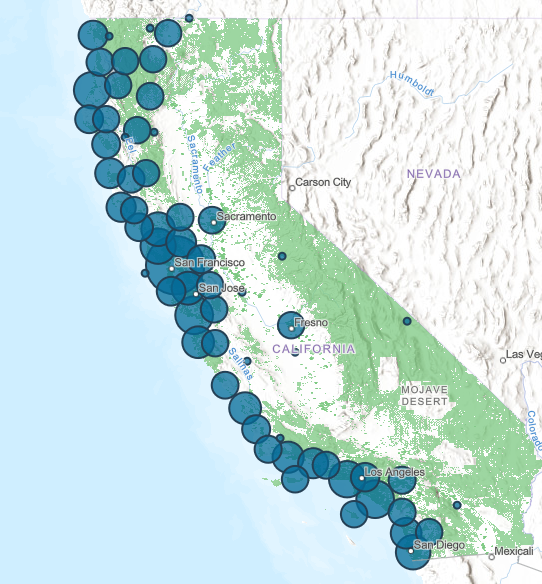Press Release: Coastal Conservancy Awards $7.8 Million for Coastal Restoration, Overnight Accommodation
Board approves first Explore the Coast Overnight Grant
Oakland, CA – Last week, the Board of the California State Coastal Conservancy awarded $7.8 million to 13 projects to protect and restore the California coast and San Francisco Bay, and increase public access to these natural resources.
Among these grants was $2 million to the Crystal Cove Conservancy to restore 17 historic cottages in Crystal Cove State Park in Orange County. This grant is the first funding to be authorized under the Conservancy’s Explore the Coast Overnight program, which funds projects and programming that create opportunities for all Californians to stay overnight at the coast. Only 21% of overnight accommodation facilities on the California coast are “lower cost[1]” . Of that, 62% are camping sites or RV sites, leaving a very small number of “lower cost” hotels and motels to serve all visitors. The Explore the Coast Overnight program seeks to increase the number of cabins, hostels, hotels, campgrounds and other overnight options available at a rate within reach of most Californians.
The projects approved at the February Board meeting were:
NORTH COAST
- A grant of up to $90,000 to the Trinidad Coastal Land Trust for construction of public access improvements, including restroom, picnic area, kiosk, and bike rack, at Houda Pointin Humboldt County.
- A grant of up to $838,113 received from the California Department of Fish and Wildlife to the Humboldt County Resource Conservation District to complete construction and implement post-construction monitoring of the White Slough Restoration Projectin the Humboldt Bay National Wildlife Refuge (HBNWR) on Humboldt Bay.
SAN FRANCISCO BAY AREA
- A grant of up to $200,000 to the Solano Land Trust for construction of a staging area and other public amenities at Rockville Trails Preserveto allow access to new Bay Area Ridge Trail segments, and adoption of findings under the California Environmental Quality Act.
- A grant of up to $1,700,000 to the County of Napa to restore a two-mile reach of the Napa Riverand a one-mile secondary channel to enhance long-term river and floodplain function, improve water quality and riparian habitats, and attenuate flood damage to adjacent properties.
- A grant of up to $239,719 to Friends of Corte Madera CreekWatershed to prepare design criteria, alternatives, and 35% design drawings for channel modifications to improve salmonid fish passage in a 3,100-foot long reach of concrete channel in the Corte Madera Creek in Marin County.
- A grant of up to $485,993, to the Alameda County Resource Conservation District to implement the Water for Wildlife, East Bay Rangeland Pond and Trough Enhancement Projectin Alameda and Contra Costa Counties, and adoption of findings under the California Environmental Quality Act.
- A grant of up to $500,000 to the Association of Bay Area Governments to prepare 60% designs and permit applications for thePalo Alto Horizontal Levee Pilot Project adjacent to the Palo Alto Regional Water Quality Control Plant, City of Palo Alto, Santa Clara County.
CENTRAL COAST
- A grant of up to $300,000 to the Land Trust of Santa Cruz County to prepare plans, designs, environmental review documents, and permit applications for approximately five miles of public trails and a trail staging area at the Watsonville Slough Farm.
- A grant of up to $40,000 to the County of Santa Barbara to prepare a design and feasibility study for the Santa Maria River Levee Trailin Santa Barbara County.
- Consideration and possible authorization disburse up to $670,000 of grant funds from the California Natural Resources Agency’s Regional Forest and Fire Capacity Programto the Contra Costa and San Mateo County Resource Conservation Districts and the Amah Mutsun Land Trust to augment the Conservancy’s October 17, 2019 authorization to disburse funds for planning and implementation projects that will improve forest health and wildfire resiliency, facilitate greenhouse gas emissions reductions, and increase carbon sequestration in forests.
SOUTH COAST
- A grant of up to $500,000 to the City of Long Beach to construct a water treatmentfacility and two acres of surrounding green space that will include a one-acre wetland and trails that connect two parks and provide an inland connection to the California Coastal Trail, in the Willmore neighborhood of Long Beach, and adoption of findings under the California Environmental Quality Act.
- A grant of up to $318,600 to the Ventura Port District to install a one-ton derrick crane at the Ventura Harbor Commercial Fish Pierand enhance a commercial fishing gear storage and net repair facility at Ventura Harbor in Ventura County.
- A grant of up to $2,000,000 to the Crystal Cove Conservancy to restore 17 historic cottages on North Beach of the Crystal CoveHistoric District at Crystal Cove State Park in Orange County, and adoption of findings under the California Environmental Quality Act.
Notes to Editors:
The Coastal Conservancy is a state agency, established in 1976, to protect and improve natural lands and waterways, to help people get to and enjoy the outdoors, and to sustain local economies along California’s coast. The Conservancy is a non-regulatory agency that supports projects to protect coastal resources and increase opportunities for the public to enjoy the coast.
Since its founding, the Conservancy has:
- Funded 2,400 projects along the California coastline and in the San Francisco Bay.
- Protected 390,000 acres of coastal lands through acquisition of fee title and conservation easements.
- Restored 33,000 acres of habitat.
- Built 200 new coastal accessway and 210 miles of new trails.
- Put $1.3 billion to work for conservation projects, and leveraged far more from federal, local government, and private sources.
[1] There are numerous ways of defining “lower-cost” with regard to accommodations, and lower cost does not necessarily translate to affordability for people of low and middle-incomes. For the Sustinere analysis used in the Conservancy’s 2019 Assessment of Lower-Cost Coastal Accommodations, “lower-cost” coastal accommodations were defined as those having a daily rate that was 75% or less of the statewide average daily rate in 2015.
Latest News
- Job Posting: Deputy Executive Officer C. E. A.“Love the California Coast, the environment, supervising people, and public agency management? This might be the job for you!” The State Coastal Conservancy is seeking an experienced leader to join our Executive Management team as the Deputy Executive Officer, CEA, range A. Reporting to and assisting the Executive Officer, the Deputy Executive Officer develops and […] (Read more on Job Posting: Deputy...)
- Press Release: State, Regional Agencies Join Forces to Prepare Bay Area for Sea Level Rise, Increased FloodingMemorandum Marks Commitment to Coordinated Efforts SAN FRANCISCO, July 22, 2024… Seven regional and state public agencies have executed a new memorandum of understanding committing each agency to a joint work program to address increased threats of flooding and sea level rise in the nine-county San Francisco Bay Area region. The agencies participating in the […] (Read more on Press Release: State,...)
- San Francisco Bay Area Water Trail Implementation Meeting #42 – June 21, 2024, 10am – 12pmAGENDA June 21 , 2024 10:00 a.m. – 12:00 p.m. VIRTUAL MEETING Zoom Meeting Information: Please join us on Zoom at this link: https://scc-ca-gov.zoom.us/meeting/register/tZEtcumrqTMrHdeYKO2888Cqs7e8id82p4VD Desired Outcomes of Meeting: Attendees are informed of Water Trail-related activities, progress, and accomplishments Attendees are informed about a new water access audio tour from guest speaker Attendees are informed of […] (Read more on San Francisco Bay...)

 Help Save Sea Otters at Tax Time
Help Save Sea Otters at Tax Time

